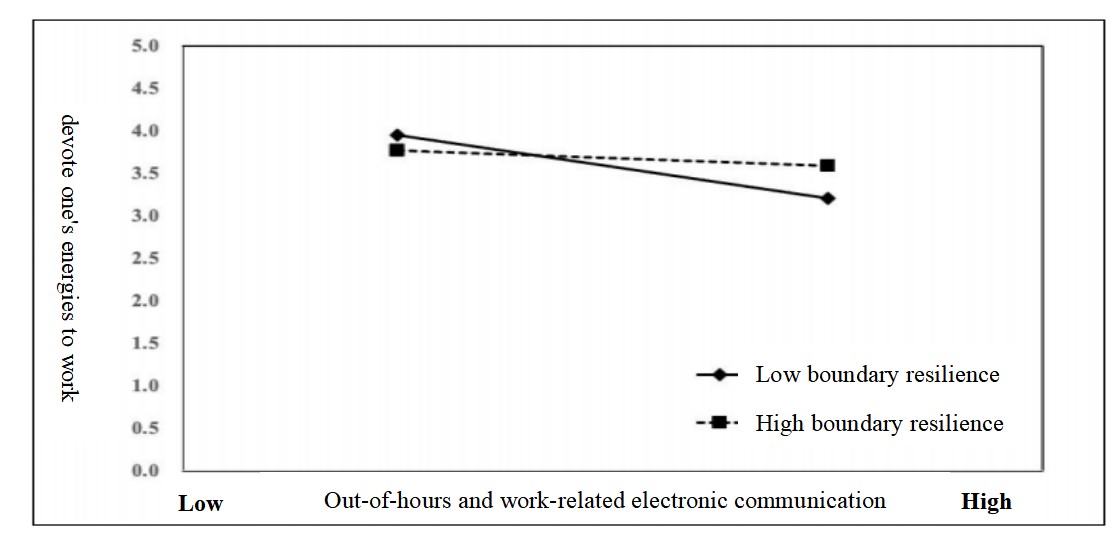Impact of Off-Hours Work-Related Electronic Communication on Work Engagement Among University Faculty: The Moderating Role of Boundary Flexibility
Abstract
With the rapid development of information and communication technology and new office forms, non-working time and work-related electronic communication has become an essential part of people's work and life. Teachers in colleges and universities also have the same phenomenon in their daily work, but different teachers have different evaluations of this work status, and there are differences in the impact of different work motives. The article explores the mechanism of the influence of non-working time and work-related electronic communication on work engagement by taking teachers in college A as the research object, and selects boundary flexibility ability as the moderating variable. The results show that non-working time and work-related e-communication have a significant negative effect on work engagement of teachers in college A. Boundary elasticity ability plays a negative moderating role between non-working time and work-related e-communication and work engagement, and there is a significant difference between different work motives. The findings of the study provide theoretical basis and practical support for moderately controlling non-work time and work-related e-communication and enhancing college teachers' work engagement.
References
Cheng, H., Chen, S., & Guo, K. (2023). A review of research on non-working hours and work-related electronic communication and future prospects. China Human Resource Development, 40(1), 6–20.
Wang, Q. (2023). Research on the effect of non-working time electronic communication on employees' work withdrawal behavior [Master’s thesis, Beijing University of Information Science and Technology].
Li, Y. (2022). The effect of off-hours work connectivity behavior on employee proactive behavior: The role of employee dynamics and segmentation preferences [Master’s thesis, Southwest University of Finance and Economics].
Ru, Y. (2022). The effects of electronic communication on emotional exhaustion during non-working hours [Master’s thesis, Southwest University of Finance and Economics].
Deci, E. L., & Ryan, R. M. (2000). The “what” and “why” of goal pursuits: Human needs and the self-determination of behavior. Psychological Inquiry, 11(4), 227–268. https://doi.org/10.1207/S15327965PLI1104_01
Ohly, S., & Latour, A. (2014). Work-related smartphone use and well-being in the evening: The role of autonomous and controlled motivation. Journal of Personnel Psychology, 13(4), 174–183. https://doi.org/10.1027/1866-5888/a000114
Lv, X., & Shen, Z. (2024). A study on the influencing factors of international Chinese learners' motivation in a blended learning context. Journal of Hainan Normal University (Social Science Edition), 37(5), 109–117.
Boswell, W. R., Olson-Buchanan, J. B., Butts, M. M., et al. (2016). Managing “after hours” electronic work communication. Organizational Dynamics, 45(4), 291–297. https://doi.org/10.1016/j.orgdyn.2016.10.004
Gadeyne, N., Verbruggen, M., Delanoeije, J., et al. (2018). All wired, all tired? Work-related ICT-use outside work hours and work-to-home conflict: The role of integration preference, integration norms and work demands. Journal of Vocational Behavior, 107, 86–99. https://doi.org/10.1016/j.jvb.2018.03.008
Kahn, W. A. (1990). Psychological conditions of personal engagement and disengagement at work. Academy of Management Journal, 33(4), 692–724. https://doi.org/10.2307/256287
Britt, T. W., Adler, A. B., & Bartone, P. T. (2001). Deriving benefits from stressful events: The role of engagement in meaningful work and hardiness. Occupational Health Psychology, 6(1), 53–63. https://doi.org/10.1037/1076-8998.6.1.53
Schaufeli, W. B., Salanova, M., González-Romá, V., et al. (2002). The measurement of engagement and burnout: A confirmative analytic approach. Journal of Happiness Studies, 3(1), 71–92. https://doi.org/10.1023/A:1015630930326
Clark, S. C. (2000). Work/family border theory: A new theory of work/family balance. Human Relations, 53(6), 747–770. https://doi.org/10.1177/0018726700536001
Matthews, R. A., & Barnes-Farrell, J. L. (2010). Development and initial evaluation of an enhanced measure of boundary flexibility for the work and family domains. Journal of Occupational Health Psychology, 15(3), 330. https://doi.org/10.1037/a0019302
Hobfoll, S. E. (1989). Conservation of resources: A new attempt at conceptualizing stress. American Psychologist, 44(3), 513–524. https://doi.org/10.1037/0003-066X.44.3.513
Hobfoll, S. E., Halbesleben, J., Neveu, J. P., et al. (2018). Conservation of resources in the organizational context: The reality of resources and their consequences. Annual Review of Organizational Psychology and Organizational Behavior, 5(1), 103–128. https://doi.org/10.1146/annurev-orgpsych-032117-104640
Ye, S. (2022). Noncompliance tasks and work-family conflict: The mediating role of psychological disengagement and the moderating role of boundary resilience competencies [Master’s thesis, Henan University].
Xu, X. (2022). The effect of boundary flexibility ability on individual prosperity of new generation employees: The mediating role of work-family gain and the moderating role of boundary flexibility willingness [Master’s thesis, Jiangxi University of Finance and Economics].
Liao, H., Huang, L., & Hu, B. (2022). Resource conservation theory in organizational behavior: Evolution and challenges. Advances in Psychological Science, 30(2), 449–463. https://doi.org/10.3724/SP.J.1042.2022.00449
He, Y., & Yu, J. (2020). The effect of non-working time electronic communication on employees' time encroachment behavior: Based on the perspective of resource preservation theory. China Human Resource Development, 37(1), 54–67.
Yuan, X. (2021). A two-path study of the effects of non-work time work-related electronic communication on employees' work engagement [Master’s thesis, Shanxi University].
Christian, M. S., Garza, A. S., & Slaughter, J. E. (2011). Work engagement: A quantitative review and test of its relations with task and contextual performance. Personnel Psychology, 64(1). https://doi.org/10.1111/j.1744-6570.2010.01203.x
Zhao, Y., Wang, Y., Wang, C., et al. (2024). A meta-analytic study of non-work time work connectivity behaviors affecting work feelings and work behaviors. Applied Psychology, 1–18. https://doi.org/10.20058/j.cnki.CJAP.024043
Lanaj, K., Johnson, R. E., & Barnes, C. M. (2014). Beginning the workday yet already depleted? Consequences of late-night smartphone use and sleep. Organizational Behavior & Human Decision Processes, 124(1), 11–23. https://doi.org/10.1016/j.obhdp.2014.01.001
Wan, J., Zhou, W., Zhou, H., et al. (2023). Effects of psychological disengagement on work engagement: Facilitation or inhibition? Advances in Psychological Science, 31(2), 209–222. https://doi.org/10.3724/SP.J.1042.2023.00209
Xu, J., & Lu, H. (2018). Work-family conflict and turnover propensity—The moderating role of boundary resilience capacity. Technology and Management.
Boswell, W. R., & Olson-Buchanan, J. B. (2007). The use of communication technologies after hours: The role of work attitudes and work-life conflict. Management, 33(4), 592–610. https://doi.org/10.1177/0149206307302552
Ma, H., Xie, J., Tang, H., et al. (2016). Work-based communication tool use and the well-being of dual-career couples: An analysis based on spillover–crossover effects. Journal of Psychology, 48(1), 48–58. https://doi.org/10.3724/SP.J.1041.2016.00048
Ma, H., Shen, C., Yang, J., et al. (2014). The relationship between boundary flexibility and work-family conflict and gain: A perspective based on person-environment matching. Journal of Psychology, 46(4), 540–551. https://doi.org/10.3724/SP.J.1041.2014.00540
Grant, A. M., Gino, F., & Hofmann, D. A. (2011). Reversing the extraverted leadership advantage: The role of employee proactivity. Academy of Management Journal, 54(3), 528–550. https://doi.org/10.5465/amj.2011.61968043
Ni, Q., Pan, C., & Lu, Y. (2022). A study on the impact of dual time pressure on the work prosperity of young college teachers. Journal of Beijing University of Chemical Technology (Social Science Edition), (1), 22–31, 82.
Robinson, C., & Schumacker, R. E. (2009). Interaction effects: Centering, variance inflation factor, and interpretation issues. Multiple Linear Regression Viewpoints, 35(1), 6–11.


This work is licensed under a Creative Commons Attribution 4.0 International License.
Copyright for this article is retained by the author(s), with first publication rights granted to the journal.
This is an open-access article distributed under the terms and conditions of the Creative Commons Attribution license (http://creativecommons.org/licenses/by/4.0/).









1.png)














